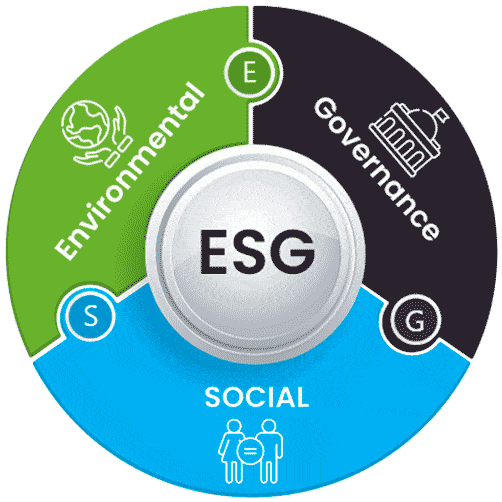Investors, shareholders and consumers are increasingly focusing on companies whose ESG index falls within established global criteria. In this article, we look at how leading companies are setting and planning their ESG standards, and how internal communication is becoming a key area for implementation.
The importance of ESG criteria in Organizations
ESG criteria refer to the environmental, social and governance aspects that companies consider in their operations and decision-making.

Today, they are the backbone of any business. According to the Global Sustainable Investment Review, 78% of investors incorporate ESG criteria in their investment policies.
Benefits of integrating ESG criteria
Exploring the economic, social and environmental benefits of adopting ESG criteria.

1- Environmental:
It includes all environmental criteria related to practices and policies that affect a company’s impact on the environment. While each sector and/or industry may have unique characteristics, some common aspects include:
Companies can put these criteria into practice through measures such as adopting clean technologies, implementing recycling policies, reducing emissions, promoting renewable energy and integrating sustainable practices into their supply chains.

2- Social:
Social criteria refer to policies and practices related to a company’s impact on society and its stakeholders, including employees, customers, local communities and other stakeholders. Some key aspects include:
- Diversity and inclusion.
- Pay equity.
- Fair working conditions.
- Occupational health and safety.
- Human rights.
- Data privacy.
- Commitment to local communities.
- Corporate social responsibility in general.
The most innovative companies put these criteria into practice through initiatives such as diversity and inclusion programs, ethical labor practices, promotion of gender equality, support for social causes, community investment, and stakeholder dialogue.

3- Gobernance:
These criteria relate to a company’s governance structure, policies, processes and decision-making practices. They include aspects such as:
- Transparency.
- Accountability.
- Business ethics.
- Risk management.
- Executive compensation.
- Board composition.
- Shareholder rights.

Companies can put these criteria into practice by establishing sound corporate governance policies, adopting codes of conduct, promoting financial reporting transparency, board independence and responsible risk management.
Implementing with intelligence
On the other hand, companies implement ESG criteria in different ways, depending on their size, industry and context:
- Integration of ESG criteria into business strategy and decision-making processes.
- Establishment of clear policies and standards in relation to ESG aspects.
- Implementation of environmental and social management systems.
- Conducting regular audits and evaluations to monitor and improve ESG performance.
- Investing in sustainable technologies and energy efficiency practices.
- Establishment of training and awareness programs for employees.
Let's talk numbers
Global ESG assets surpassed $41 trillion in 2022 and may rise to $50 trillion by 2025, one-third of total projected assets under management globally, according to a new report from Bloomberg Intelligence (BI).

In recent years, there has been a significant increase in interest and adoption of ESG criteria by companies and corporations:
- ESG indexes: The number of stock market indexes that integrate ESG criteria has increased significantly. According to the World Federation of Exchanges (WFE), more than 600 stock indexes worldwide include ESG metrics in their design.
- Sustainability reporting: A growing number of companies are issuing sustainability reports to inform investors and other stakeholders about their ESG practices. According to a report by the consulting firm KPMG, 80% of the world's 5,200 largest companies include sustainability information in their annual reports.
- Investor engagement: Investors are playing a key role in promoting ESG criteria.
- Government regulations: many governments are introducing regulations and regulatory frameworks related to ESG disclosure and compliance. For example, the European Union implemented the EU Taxonomy for Sustainability and the Sustainable Finance Disclosure Directive in 2021.
The role of internal communication in ESG
Internal communication can play an important role in promoting environmental, social and governance (ESG) practices within an organization.
In what way?
Awareness and education
Through strategic planning, IC can help raise employee awareness of relevant environmental, social and governance issues and engage them in concrete actions. This may include disseminating information on sustainability policies, fair labor practices, diversity and inclusion, business ethics, and other ESG-related topics.
Transparency and accountability
CI can foster transparency by informing stakeholders about ESG-related initiatives and challenges in the organization through the disclosure of key metrics, sustainability reports, audit results and other relevant data. Keeping them informed fosters a culture of accountability and reinforces commitment to ESG.
Participation and collaboration
Engaging employees in ESG-related activities is key. This can include inviting ideas, suggestions and feedback on how to improve sustainable practices, promote corporate social responsibility and strengthen corporate governance. By encouraging active participation, a sense of ownership and commitment to ESG is generated throughout the organization.
Education and training
CI’s strategic plan may include training and education programs on ESG issues. Through workshops, lectures, newsletters, online resources and other means, we promote understanding of the importance of sustainability, social responsibility and effective governance practices.
Recognition and celebration
Establish a space to recognize and celebrate the achievements of teams in relation to ESG. This may include disseminating success stories, presenting awards or recognitions, and creating platforms to highlight those who have made significant contributions in terms of sustainability, social responsibility and responsible governance.
At Oxean, we are ready to accompany your company in the creation and development of an IC strategic plan with the objectives of informing, involving, educating and celebrating results in relation to ESG criteria.




